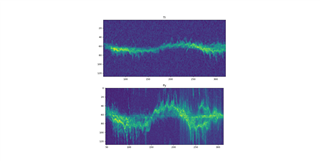Dear,
I am using the iwr6843aopevm radar in two ways. The first one is by collecting the raw data with the DCA board and mmwaveboost card, and then I have a python code to process that data and get the the micro doppler map.
I also use the out of box demo in which I added some code to get micro doppler map by using the detection matrix. The image below shows the results of both pipelines, the spectrums are a bit different in terms of energy in higher doppler bins.
What does not make sense is that the same configuration is used. Could you please give any hints what could make the difference?
Would this be related to the fact that using MMwaveIC Boost card gives better quality of signal?
Best regards,
Reda


